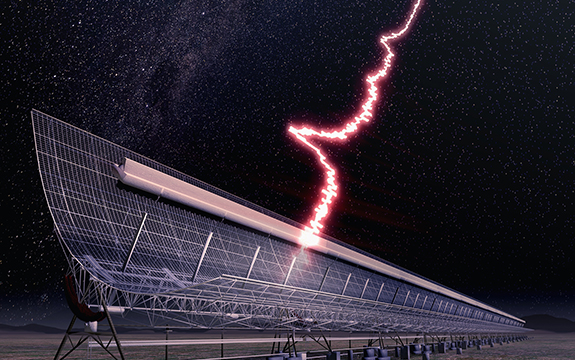Swinburne uses AI to detect fast radio bursts in real-time

In Summary
- A Swinburne PhD student has built an automated system that uses artificial intelligence to capture fast radio bursts (FRBs) in real-time
- Student Wael Farah is the first to discover FRBs in real-time with a fully automated, machine learning system
- Five bursts were captured using the machine learning system and published in the Monthly Notices of the Royal Astronomical Society
A Swinburne PhD student has built an automated system that uses artificial intelligence (AI) to revolutionise our ability to detect and capture fast radio bursts (FRBs) in real-time.
FRBs are mysterious and powerful flashes of radio waves from space, thought to originate billions of light years from the Earth. They last for only a few milliseconds (a thousandth of a second) and their cause is one of astronomy’s biggest puzzles.
Wael Farah developed the FRB detection system, and is the first person to discover FRBs in real-time with a fully automated, machine learning system. Mr Farah’s system has already identified five bursts – including one of the most energetic ever detected, as well as the broadest.
His results have been published in the Monthly Notices of the Royal Astronomical Society.
Capturing fast radio bursts in real-time
Mr Farah trained the on-site computer at the Molonglo Radio Observatory near Canberra to recognise the signs and signatures of FRBs, and trigger an immediate capture of the finest details seen to date.
The bursts were detected within seconds of their arrival at the Molonglo Radio Telescope, producing high quality data that allowed Swinburne researchers to study their structure accurately, and gather clues about their origin.
Mr Farah says his interest in FRBs comes from the fact they can potentially be used to study matter around and between galaxies that is otherwise almost impossible to see.
“It is fascinating to discover that a signal that travelled halfway through the universe, reaching our telescope after a journey of a few billion years, exhibits complex structure, like peaks separated by less than a millisecond,” he says.
Molonglo project scientist, Dr Chris Flynn says: “Wael has used machine learning on our high-performance computing cluster to detect and save FRBs from amongst millions of other radio events, such as mobile phones, lightning storms, and signals from the Sun and from pulsars.”
Australian Research Council Laureate Fellow and project leader, Professor Matthew Bailes says: “Molonglo’s real-time detection system allows us to fully exploit its high time and frequency resolution and probe FRB properties that were previously unobtainable.”

One of the FRBs shows remarkable structure in time and radio frequency. The fine details seen here could only be captured because the computers had been trained to spot FRBs within seconds of their arrival at the Earth. Image credit: Wael Farah/Swinburne
The five bursts were found as part of the UTMOST FRB search program - a joint collaboration between Swinburne and the University of Sydney. The Molonglo telescope is owned by the University of Sydney.
World-first discoveries
In June, Swinburne astrophysicists Dr Adam Deller and Dr Ryan Shannon, from the Centre for Astrophysics and Supercomputing, were part of a team that determined the precise location of a one-off FRB for the first time.
Dr Shannon also led the discovery of 20 FRBS in 2018, nearly doubling the known number of bursts at that time.

